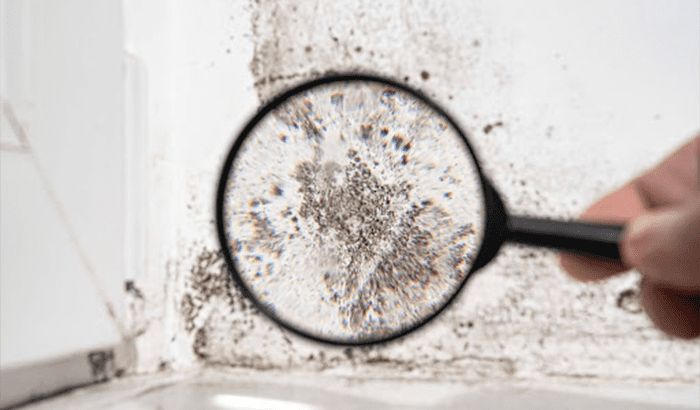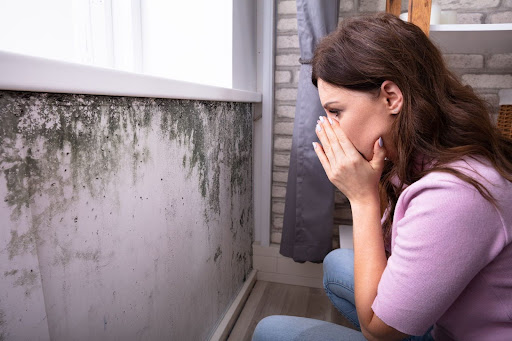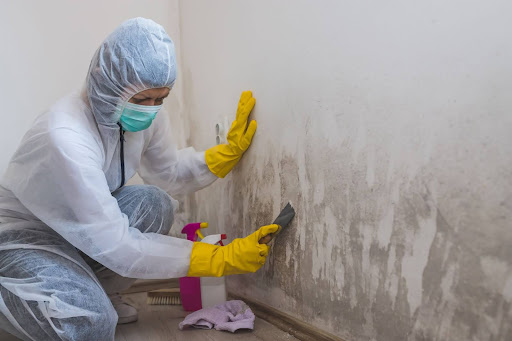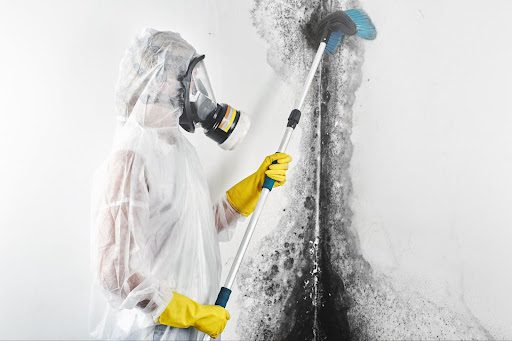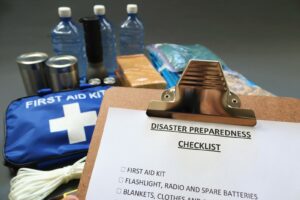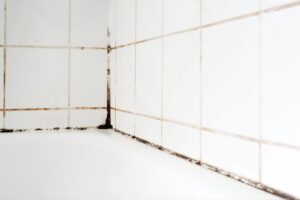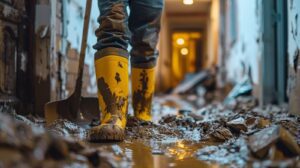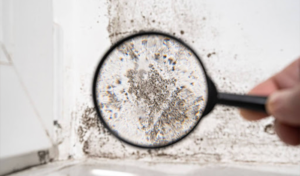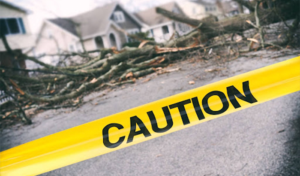There are multifaceted effects that mold has on your health, from short-term allergies to long-term complications. We’ll explore the links between mold and specific health conditions, such as the exacerbation of asthma and cognitive disturbances, and offer insights into prevention, management, and when professional mold remediation might be necessary.
Mold is a living organism that has serious repercussions on your health if left unchecked. Understanding mold — its types, habitats, and the way it reproduces — is crucial in recognizing its potential impact on your well-being.
Understanding mold
Mold is a type of fungus that consists of small organisms found almost everywhere. It can be black, white, orange, green, or purple and lives on moisture, reproducing by releasing spores that travel through the air.
When mold spores land on a wet surface, they begin to grow and digest the material they are on to survive. Mold is not always dangerous, but in large quantities, it has adverse health effects. This is because mold spores are allergens and irritants, and sometimes potentially toxic substances called mycotoxins.
Common types of mold
There are thousands of species of mold, but only a handful commonly invade homes, leading to health problems:
- Aspergillus: Often found in food and air conditioning systems, it causes allergic reactions and respiratory infections.
- Cladosporium: This type grows in cool and warm areas and is known to cause asthma symptoms and other breathing disorders.
- Penicillium: Easily recognizable by its blue or green appearance on food, it also spreads to walls and insulation.
- Black mold (Stachybotrys chartarum): Especially notorious due to its production of toxic compounds, and it’s associated with severe health risks like respiratory issues and memory loss.
Where mold is found
Mold grows in any environment that offers moisture, nutrients, and a suitable temperature. Common places for indoor mold growth include:
- Bathrooms and kitchens: Due to their typically high humidity and frequent water use.
- Basements and crawl spaces: These areas often have limited airflow and are prone to water leaks or flooding.
- Around windows and pipes: Condensation leads to mold growth on window sills or near leaky pipes.
- In heating, ventilation, and air conditioning systems: Mold grows on or inside system components like ducts or vents if moisture is paired with collected dust or other organic compounds.
Monitoring these areas for excessive moisture and promptly addressing any water leaks are essential steps to prevent extensive mold growth. Mold cannot grow without moisture, so controlling humidity levels through adequate ventilation with exhaust fans or air conditioners is also vital in mold prevention.
Mold allergies and reactions
Mold allergies are a common concern for many individuals, affecting their immune systems and leading to unpleasant allergic reactions. People with mold allergies may have sensitivities to the spores that molds release into the air. Like other allergies, an allergic reaction to mold ranges from mild to severe and sometimes drastically affects a person’s quality of life.
Due to the pervasive nature of mold spores, individuals with these allergies experience symptoms indoors and outdoors, although indoor mold exposure often poses a greater health concern.
For people with asthma or other respiratory conditions, mold has a more pronounced effect. It’s important to recognize that while anyone may experience irritation from mold exposure, those with mold allergies or compromised immune systems are more likely to suffer the effects of mold on your health.
It is not only the amount of mold, but the type of mold and an individual’s health conditions that determine the severity of the allergic reactions.
Symptoms of mold allergies
Mold allergies produce symptoms similar to other allergies. Common symptoms of mold allergies include:
- Sneezing
- Runny or stuffy nose
- Itchy throat or ears
- Watery, red, or itchy eyes
- Skin rashes
- Cough and postnasal drip
- Wheezing or difficulty breathing
Individuals sensitive to mold may also experience symptoms such as headaches and fatigue. These symptoms of mold exposure are easily mistaken for a cold or other respiratory infections. It is important to monitor when and where symptoms occur to help determine if they are caused by mold or another substance.
Allergic reactions to mold
Mold triggers both immediate and delayed allergic reactions. When a person with a mold allergy is exposed to mold spores, their immune system mounts a defense, which leads to inflammation in the nasal passages, lungs, and airways.
- Asthma symptoms in those with the condition include coughing, shortness of breath, chest tightness, and wheezing.
- Allergic fungal sinusitis is a condition where the sinuses become inflamed due to a mold infection.
- In severe cases, hypersensitivity pneumonitis is an acute or chronic lung disease caused by an immune system response to inhaled mold spores.
In people with severe mold allergies, exposure to large amounts of mold may provoke more serious reactions such as anaphylaxis — though rare.
Mold exposure and respiratory symptoms
Respiratory symptoms are the most frequently reported health effects related to mold exposure. The airborne nature of mold spores means that they are inhaled and irritate the linings of the respiratory tracts. Here’s an overview of symptoms people might experience found in the respiratory system:
| Mild Symptoms | Moderate Symptoms | Severe Symptoms |
| Congestion | Persistent cough | Severe chest tightness |
| Throat irritation | Wheezing beyond allergic | Shortness of breath |
| Slight cough | asthma | Acute lung irritation |
If exposed over longer periods, or in sensitive individuals, mold exposure leads to persistent respiratory problems, further underscoring the importance of maintaining a mold-free environment. Regular cleaning, reducing indoor humidity, and adequate circulation of air using exhaust fans or air conditioners help mitigate the risk of exposure to mold and combat the health risks associated with it.
Remember to also explore possible hidden sources of mold in the home or office, such as behind wallpaper or ceiling tiles, in or under carpets, and within wall cavities. These contribute to the overall mold burden and associated health effects.
Asthma and mold
Asthma, a chronic inflammatory disease of the airways, is easily aggravated by the presence of mold. When individuals with asthma inhale mold spores, they may experience a range of exacerbated symptoms, including:
- Increased frequency of asthma attacks
- Intensified wheezing and breathlessness
- Heightened chest tightness
- A pronounced cough
These asthma symptoms arise due to the immune system’s response to the inhaled mold spores, often increasing airway inflammation. Effective asthma management involves taking proactive measures to reduce mold exposure and regularly consulting healthcare providers for appropriate asthma care and treatment.
Impact of mold on the immune system
Mold affects the respiratory system and interacts with the immune system in complex ways. Upon encountering mold spores, a healthy immune system typically mounts a defensive response to protect the body. However, for individuals with compromised or overly sensitive immune systems, this may result in an overreaction.
Repeated or severe exposure to mold causes the immune system to be in a frequent state of alert, leading to chronic inflammation and other adverse health effects. Those with weakened immune systems, such as people undergoing chemotherapy, transplant patients, or individuals with HIV/AIDS, are particularly vulnerable to infections from certain types of mold that lead to serious fungal infections.
Long-term health effects of mold exposure
In addition to the acute symptoms such as sneezing, coughing, and irritation of the eyes and throat, extended contact with indoor mold spores poses health risks that may develop over time. Chronic respiratory conditions, persistent allergic reactions, and long-term immune system weakening are some of the concerning health outcomes.
Individuals with frequent exposure to mold may experience ongoing asthma symptoms and an increased propensity for developing asthma in those previously undiagnosed. Long-term exposure also leads to sensitivity to mold, meaning that the symptoms will occur more quickly and with more severity upon subsequent mold exposures.
Fungal infections caused by mold exposure
Fungal infections are another serious consequence of mold exposure, particularly for people with weakened immune systems. These infections may become invasive, affecting various organs and causing systemic issues. Some common fungal infections related to mold exposure include:
- Aspergillosis: A group of illnesses caused by mold, such as Aspergillus, primarily affecting the respiratory system.
- Histoplasmosis: An infection caused by inhaling the spores of a fungus commonly found in bird and bat droppings.
- Candidiasis: Typically a superficial infection, but may become systemic in immunocompromised individuals.
Such infections may lead to severe health conditions that require medical attention and long-term treatment.
Memory loss and cognitive issues
Cognitive impairments, including memory loss, confusion, and difficulty concentrating, have been reported in cases of prolonged mold exposure. Studies suggest that exposure to certain molds and their byproducts negatively affect cognitive functions, though more research is needed to fully understand this link.
The phenomenon often referenced as “mold fog” or “brain fog” hints at the possible neurotoxic effects of some species of mold that may lead to these cognitive conditions.
Early detection and remediation, in conjunction with preventive measures like controlling indoor humidity and promptly addressing water leaks, are crucial for minimizing the potential long-term health risks associated with mold exposure.
Prevention and management of mold
To safeguard health and maintain a clean and safe living environment, it’s vital to proactively prevent and diligently manage mold.
Mold thrives on moisture, so addressing problems like excessive moisture, water leaks, and high humidity is crucial. Implementing strategies such as using air conditioners and exhaust fans, regular inspections for leaks, and maintaining low indoor humidity levels can significantly halt mold in its tracks.
Prevention is often more manageable and less costly than remediation, so consistent vigilance and quick action are your strongest allies in combating the adverse health effects of mold. By minimizing the chances of extensive mold growth, you protect the structural integrity of your home and, more importantly, the health of its inhabitants.
Identifying and addressing water leaks
Water leaks are a primary contributor to mold proliferation. Inspecting your home regularly for signs of leaks, such as water stains, warping, or a musty smell, is essential. Here’s what to look for and how to handle leaks:
- Visual signs: Look for discoloration on walls, ceilings, or floors.
- Odor detection: Trust your nose; a musty smell often indicates hidden moisture.
- Tactile inspection: Feel for dampness or swelling in walls and cabinetry.
- Prompt repairs: Fix leaks immediately to prevent mold from taking hold.
Inspect areas prone to water intrusion, such as roofs, windows, and the building’s foundation, especially after severe weather events. Regularly checking water-using appliances and pipes for condensation or drips is also effective in preventing mold growth.
Professional mold remediation
Professional mold remediation is indispensable when dealing with mold, especially in large infestations or in sensitive environments. Professionals in mold remediation bring expertise, specialized equipment, and advanced techniques to handle mold problems effectively and safely. They follow stringent protocols to remove mold thoroughly without risking further contamination or exposure.
When to consider professional help
There are several circumstances in which it is wise to engage professional mold remediators:
- Extent of mold: Professional remediation is recommended if mold covers more than 10 square feet.
- HVAC contamination: Mold in your heating, ventilation, and air conditioning systems requires professional cleaning.
- Inaccessible areas: Mold found in areas difficult to access, such as inside walls or floors, is best left to professionals.
- Health concerns: Individuals with allergies, asthma, or immune disorders should avoid mold cleanup and rely on professionals.
- Water damage: Following significant water damage, especially when it involves gray or black water, professional remediation ensures thorough cleaning and sanitation.
Neglecting extensive mold growth poses severe health risks, including respiratory symptoms and structural damage. Properties with mold issues risk decreased value and marketability. Prompt and thorough professional remediation is vital for addressing mold and preventing future problems.
When facing the daunting challenge of mold remediation, entrusting the task to the professionals at Total Flood and Fire Restoration ensures comprehensive and effective solutions.
With our expertise, advanced equipment, and commitment to excellence, you can rest assured that your property will be restored to a safe and mold-free environment. Contact Total Flood and Fire Restoration today for reliable mold remediation services.

